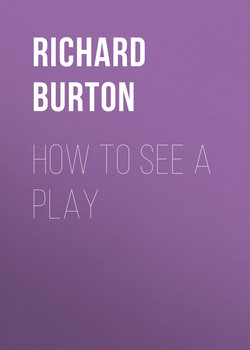How to See a Play

Реклама. ООО «ЛитРес», ИНН: 7719571260.
Оглавление
Richard Burton. How to See a Play
PREFACE
CHAPTER I. THE PLAY, A FORM OF STORY TELLING
CHAPTER II. THE PLAY, A CULTURAL OPPORTUNITY
CHAPTER III. UP TO SHAKESPEARE
CHAPTER IV. GROWTH TO THE NINETEENTH CENTURY
CHAPTER V. THE MODERN SCHOOL
CHAPTER VI. THE PLAY AS THEME AND PERSONAL VIEW
CHAPTER VII. METHOD AND STRUCTURE
CHAPTER VIII. DEVELOPMENT
CHAPTER IX. CLIMAX
CHAPTER X. ENDING THE PLAY
CHAPTER XI. THE SOCIAL SIGNIFICANCE OF THE PLAY
Отрывок из книги
THE play is a form of story telling, among several such forms: the short story, or tale; the novel; and in verse, the epic and that abbreviated version of it called the ballad. All of them, each in its own fashion, is trying to do pretty much the same thing, to tell a story. And by story, as the word is used in this book, it will be well to say that I mean such a manipulation of human happenings as to give a sense of unity and growth to a definite end. A story implies a connection of characters and events so as to suggest a rounding out and completion, which, looked back upon, shall satisfy man's desire to discover some meaning and significance in what is called Life. A child begging at the mother's knee for "the end of the story," before bedtime, really represents the race; the instinct behind the request is a sound one. A story, then, has a beginning, middle and end, and in the right hands is seen to have proportion, organic cohesion and development. Its parts dovetail, and what at first appeared to lack direction and connective significance finally is seen to possess that wholeness which makes it a work of art. A story, therefore, is not a chance medley of incidents and characters; but an artistic texture so woven as to quicken our feeling that a universe which often seems disordered and chance-wise is in reality ordered and pre-arranged. Art in its story-making does this service for life, even if life does not do it for us. And herein lies one of the differences between art and life; art, as it were, going life one better in this rearrangement of material.
Of the various ways referred to of telling a story, the play has its distinctive method and characteristics, to separate it from the others. The story is told on a stage, through the impersonation of character by human beings; in word and action, assisted by scenery, the story is unfolded. The drama (a term used doubly to mean plays in general or some particular play) is distinguished from the other forms mentioned in substituting dialogue and direct visualized action for the indirect narration of fiction.
.....
The drama in all lands is trying as never before to represent life in speech as well as act; and the strain hitherto put upon the actor, who in the past had as part of his function to make the artificial and unreal plausible and artistic, has been so far removed as to enable him to give his main strength to genuine interpretation.
The time values on the stage are a limitation which makes for artificiality; actual time must of necessity be shortened, for if true chronology were preserved the play would be utterly balked in its purpose of presenting a complete story that, however brief, must cover more time than is involved in what is shown upon the boards of a theater. As a result all time values undergo a proportionate shrinkage. This can be estimated by the way meals are eaten on the stage. In actual life twenty minutes are allotted for the scamped eating time of the railway station, and we all feel it as a grievance. Half an hour is scant decency for the unpretentious private meal; and as it becomes more formal an hour is better, and several hours more likely. Yet no play could afford to allow twenty minutes for this function, even were it a meal of state; it would consume half an act, or thereabouts. Consequently, on the stage, the effect of longer time is produced by letting the audience see the general details of the feast; food eaten, wine drunk, servants waiting, and conversation interpolated. It is one of the demands made upon the actor's skill to make all these condensed and selected minutiæ of a meal stand for the real thing; once more art is rearranging life, under severe pressure. If those interested will test with watch in hand the actual time allowed for the banquet in A Parisian Romance, so admirably envisaged by the late Richard Mansfield, or the famous Thanksgiving dinner scene in Shore Acres, fragrantly associated with the memory of the late James A. Herne, they will possibly be surprised at the brevity of such representations.
.....